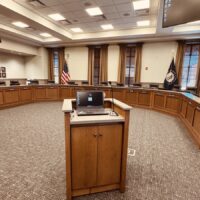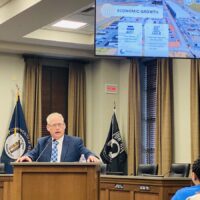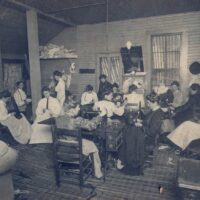Hopkinsville planning officials approved a draft solar energy system policy that says large-scale operations with ground-mounted panels must be set back at least 1,000 feet from property boundaries and at least 2,000 feet from residences, schools, hospitals and nursing homes.
The Community and Development Services governing board approved the amendment to the city’s Code of Ordinances following a public hearing Monday night in city council chambers. It will be forwarded to Hopkinsville City Council and requires two council votes to be adopted.
Currently there are no zoning regulations in the city or county for solar energy systems. There are state regulations that apply, but when local ordinances are enacted they take precedence over the state rules, said CDS executive director Tom Britton.
Most of the comments during the public hearing dealt with the setback requirements for large operations, generally known as solar farms.

Officials with BrightNight, a firm interested in developing projects in Christian County, wanted the board to reduce the setback distances. Company representative Michael Wallace said the 1,000 and 2,000 feet setbacks are “the most stringent” he’s seen in the country. BrightNight is currently developing 60 to 80 solar generation projects in the United States, including seven in Kentucky, he said.
One of those would be located on Marby Schlegel’s family farm on Pembroke Road near the bypass. Schlegel, a former Hopkinsville City Council member, said she sees the solar project as a way to ensure she keeps the farm in her family for the next generation. The land is in the city limits.
Wallace said he would rather see the city establish setback distances based on a request made by the property owner through a conditional use process.
Britton said planning officials chose to follow the state’s setback distances. Developers would have the option of seeking a conditional use allowing them to have a reduced setback distance, he said.
The draft policy headed to city council sets regulations for three types of ground-mounted solar systems:
- Small scale — with a footprint less than 2,500 square feet.
- Intermediate scale — with a footprint between 2,501 and 10 acres.
- Large scale — more than 10 acres.
The policy also addresses regulations for solar systems integrated into building materials, such as a light fixture, and for rooftop solar panels.
Most of the adverse concerns with solar systems are in large operations, said Britton.
Phil Garnett, a Bradshaw Road resident who runs one of the largest farming operations in Western Kentucky, said he appreciated the rights of landowners to decide how to use their property but added he doesn’t want to see solar farms everywhere he drives.
“Nobody knows what this will look like in 10 years,” he said.
Wayne Hunt said he doesn’t want to see Christian County farmland taken out of production. He said he has invested $2 million in solar rooftop systems for his Agri-Chem business sites in six states. But that’s different than ground-mounted systems that replace crops, he said.
“I’m all about protecting Christian County,” he said.
CDS board members Jim Fleming and Jack Elliott supported reducing the setback distances to 125 feet from property boundaries and structures such as houses, but the other board members present — Ron Adams, Rachel Smith, David Brame, Ben Bolinger, Michael Cansler, Gwenda Motley and Dan Thomas — voted to leave the distances at 1,000 feet for property boundaries and 2,000 for residential neighborhoods, hospitals, schools and nursing homes.
The public hearing was conducted to repeat another hearing in August, when the audio system malfunctioned and prevented CDS from creating a record of the session.
Jennifer P. Brown is co-founder, publisher and editor of Hoptown Chronicle. You can reach her at editor@hoptownchronicle.org. Brown was a reporter and editor at the Kentucky New Era, where she worked for 30 years. She is a co-chair of the national advisory board to the Institute for Rural Journalism and Community Issues, governing board past president for the Kentucky Historical Society, and co-founder of the Kentucky Open Government Coalition. She serves on the Hopkinsville History Foundation's board.





